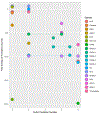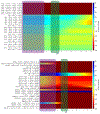Intersection of Biotic and Abiotic Sulfur Chemistry Supporting Extreme Microbial Life in Hot Acid
- PMID: 33979170
- PMCID: PMC10562994
- DOI: 10.1021/acs.jpcb.1c02102
Intersection of Biotic and Abiotic Sulfur Chemistry Supporting Extreme Microbial Life in Hot Acid
Abstract
Microbial life on Earth exists within wide ranges of temperature, pressure, pH, salinity, radiation, and water activity. Extreme thermoacidophiles, in particular, are microbes found in hot, acidic biotopes laden with heavy metals and reduced inorganic sulfur species. As chemolithoautotrophs, they thrive in the absence of organic carbon, instead using sulfur and metal oxidation to fuel their bioenergetic needs, while incorporating CO2 as a carbon source. Metal oxidation by these microbes takes place extracellularly, mediated by membrane-associated oxidase complexes. In contrast, sulfur oxidation involves extracellular, membrane-associated, and cytoplasmic biotransformations, which intersect with abiotic sulfur chemistry. This novel lifestyle has been examined in the context of early aerobic life on this planet, but it is also interesting when considering the prospects of life, now or previously, on other solar bodies. Here, extreme thermoacidophily (growth at pH below 4.0, temperature above 55 °C), a characteristic of species in the archaeal order Sulfolobales, is considered from the perspective of sulfur chemistry, both biotic and abiotic, as it relates to microbial bioenergetics. Current understanding of the mechanisms involved are reviewed which are further expanded through recent experimental results focused on imparting sulfur oxidation capacity on a natively nonsulfur oxidizing extremely thermoacidophilic archaeon, Sulfolobus acidocaldarius, through metabolic engineering.
Figures








Similar articles
-
Determinants of sulphur chemolithoautotrophy in the extremely thermoacidophilic Sulfolobales.Environ Microbiol. 2019 Oct;21(10):3696-3710. doi: 10.1111/1462-2920.14712. Epub 2019 Jul 9. Environ Microbiol. 2019. PMID: 31188531
-
The genome sequence of the metal-mobilizing, extremely thermoacidophilic archaeon Metallosphaera sedula provides insights into bioleaching-associated metabolism.Appl Environ Microbiol. 2008 Feb;74(3):682-92. doi: 10.1128/AEM.02019-07. Epub 2007 Dec 14. Appl Environ Microbiol. 2008. PMID: 18083856 Free PMC article.
-
Genome analysis of the thermoacidophilic archaeon Acidianus copahuensis focusing on the metabolisms associated to biomining activities.BMC Genomics. 2017 Jun 6;18(1):445. doi: 10.1186/s12864-017-3828-x. BMC Genomics. 2017. PMID: 28587624 Free PMC article.
-
Extremely thermoacidophilic archaea for metal bioleaching: What do their genomes tell Us?Bioresour Technol. 2024 Jan;391(Pt B):129988. doi: 10.1016/j.biortech.2023.129988. Epub 2023 Nov 9. Bioresour Technol. 2024. PMID: 37949149 Review.
-
Dissimilatory oxidation and reduction of elemental sulfur in thermophilic archaea.J Bioenerg Biomembr. 2004 Feb;36(1):77-91. doi: 10.1023/b:jobb.0000019600.36757.8c. J Bioenerg Biomembr. 2004. PMID: 15168612 Review.
Cited by
-
Chalcopyrite bioleaching efficacy by extremely thermoacidophilic archaea leverages balanced iron and sulfur biooxidation.Bioresour Technol. 2024 Sep;408:131198. doi: 10.1016/j.biortech.2024.131198. Epub 2024 Aug 6. Bioresour Technol. 2024. PMID: 39097239 Free PMC article.
-
Phenotype-driven assessment of the ancestral trajectory of sulfur biooxidation in the thermoacidophilic archaea Sulfolobaceae.mBio. 2024 Aug 14;15(8):e0103324. doi: 10.1128/mbio.01033-24. Epub 2024 Jul 2. mBio. 2024. PMID: 38953360 Free PMC article.
References
-
- Wheaton G; Counts J; Mukherjee A; Kruh J; Kelly R, The Confluence of Heavy Metal Biooxidation and Heavy Metal Resistance: Implications for Bioleaching by Extreme Thermoacidophiles. Minerals-Basel 2015, 5 (3), 397–451.
-
- Mcdonough WF; Sun SS, The Composition of the Earth. Chem Geol 1995, 120 (3-4), 223–253.
-
- King PL; McLennan SM, Sulfur on Mars. Elements 2010, 6 (2), 107–112.
-
- Elemental Sulfur: Chemistry and Physics. Interscience Publishers: 1965.
Publication types
MeSH terms
Substances
Grants and funding
LinkOut - more resources
Full Text Sources
Other Literature Sources
Research Materials

